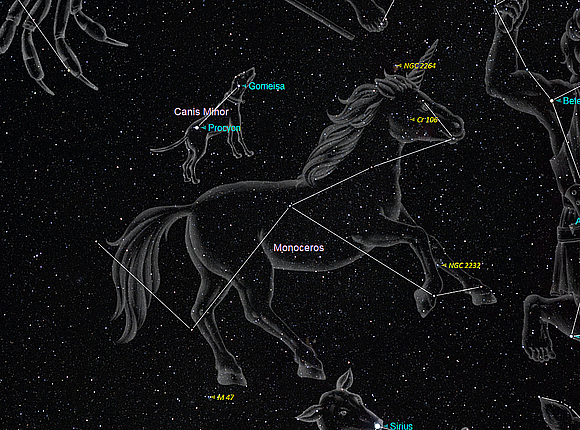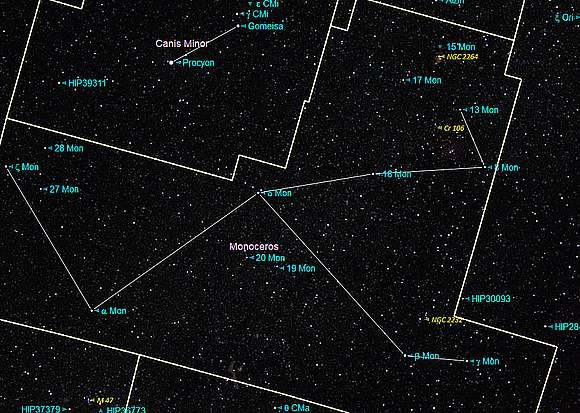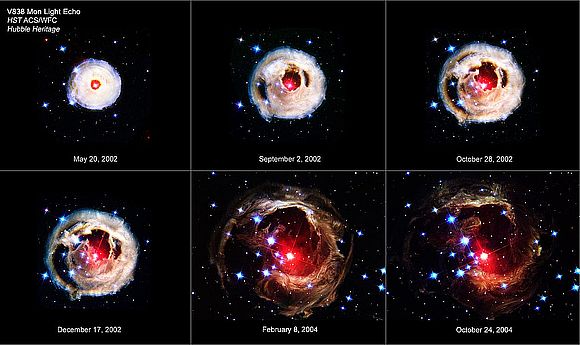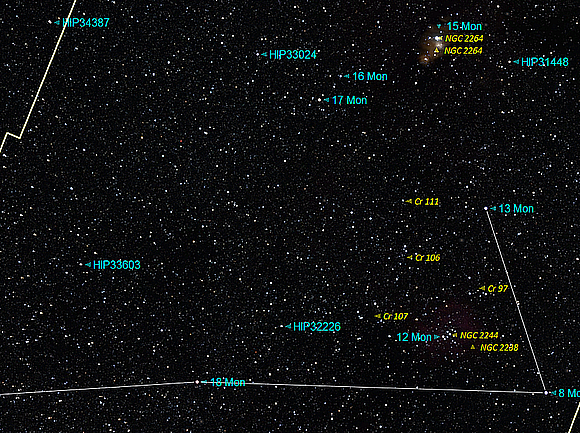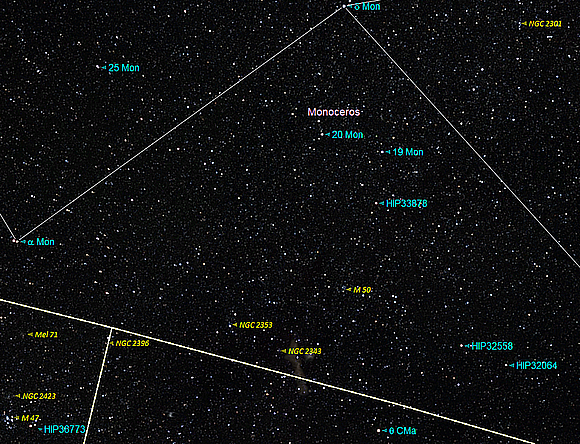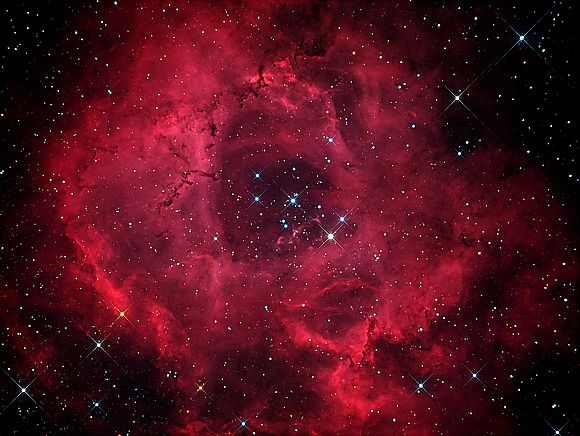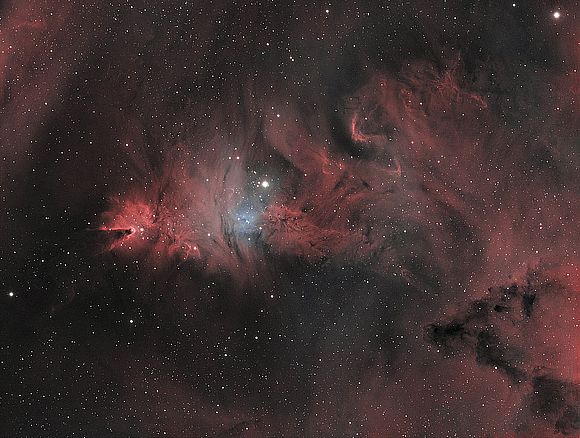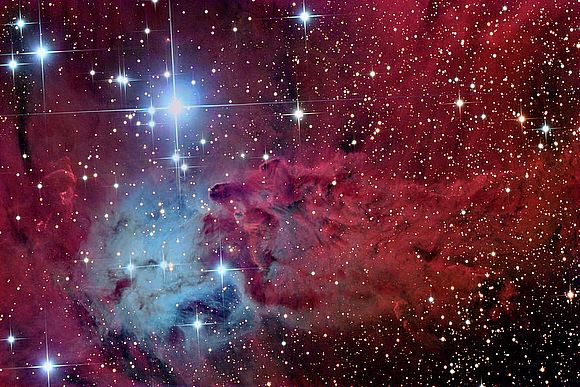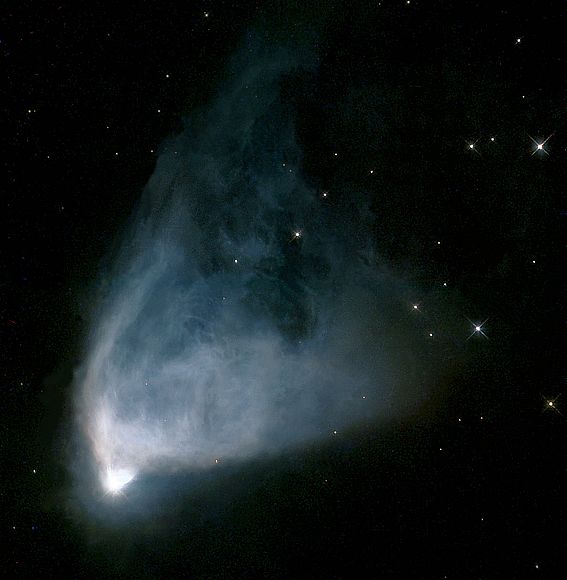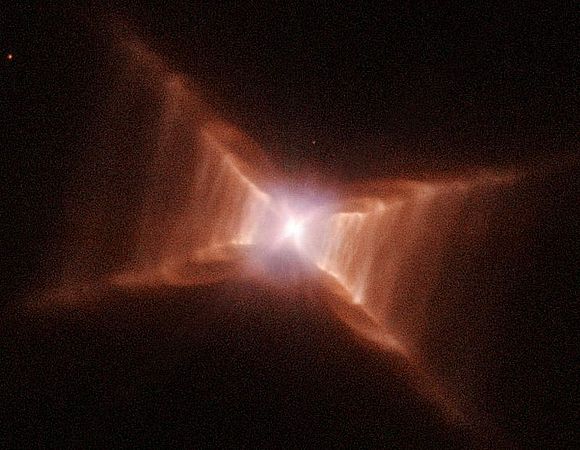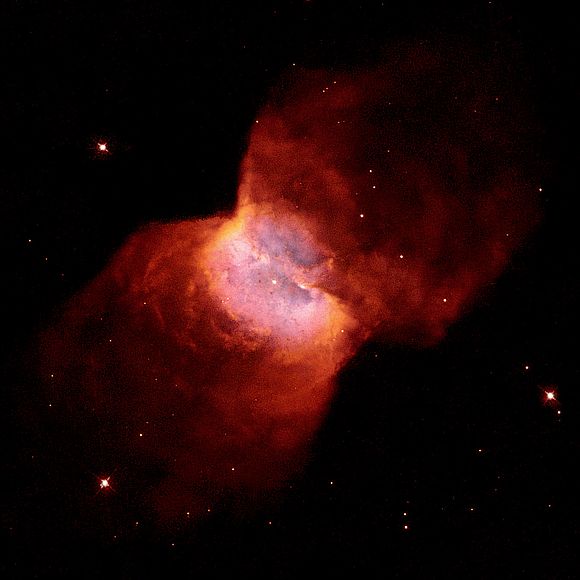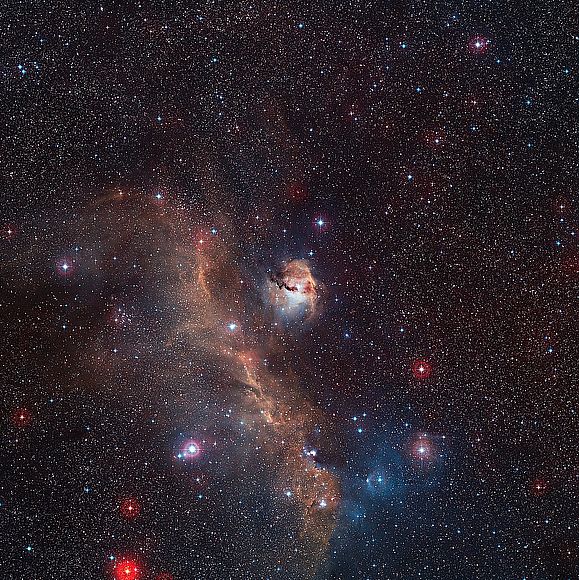Monoceros - the Unicorn (abbrev - Mon), lies on the celestial equator and is one of 15 constellations to do so. The constellation is ranked 35th in size, occupying an area of 482 square degrees. Monoceros belongs to the Orion family of constellations and is neighboured by Canis Major, Canis Minor, Gemini, Hydra, Lepus, Orion and Puppis. Monocerus is not one of the original 48 constellations, being comparatively new and first appeared on a globe by the Dutch cartographer and clergyman Petrus Plancius in 1612 as Monoceros Unicornis, created to fill the area between two large constellations of Orion and Hydra. Plancius introduced the unicorn figure because the mythical animal appears several times in the Old Testament of the Bible, but is not associated with any particular myth.
Illustrated horse with ice cream cone attached.
Otherwise known as Monocerus - the Unicorn. (Click for larger image)
Unlike its neighbours, Monocerus is not blessed with bright luminaries, although the constellation partly resides within the winter Milky Way and contains only a few fourth magnitude stars. Monocerus is however blessed with numerous deep sky objects and is home to several notable stars: the famous variables S Monocerotis, R Monocerotis and V838 Monocerotis, Plaskett’s Star, which is one of the most massive binary stars known, and the triple star Beta Monocerotis. Monoceros contains one Messier object – the open cluster M50 (NGC 2323) but does contain several interesting and famous deep sky objects: the Rosetta Nebula, the Christmas Tree nebula, the Cone nebula and Hubble’s Variable Nebula, among others. There are two meteor showers associated with the constellation: the December Monocerids and the Alpha Monocerids.
Monocerus Stars
α Monocerotis (Alpha Monocerotis) is the second brightest star in Monoceros. It is an orange giant of K0 III classification. It has an apparent magnitude of 3.94 and is approximately 144 light years distant from the Sun. The star has a stellar mass 2.02 and a radius 10.1 times.
β Monocerotis (Beta Monocerotis) is a triple star system requiring binoculars to resolve into individual stars. The system has a combined apparent magnitude of 3.74 and is approximately 700 light years distant from Earth. It is the brightest visible star in Monoceros. All three components: Beta Monocerotis A, B and C are all B-class stars with circumstellar disks orbiting them. There is also a fourth companion, a 12th magnitude star, visible nearby, but it is a line-of-sight companion and not physically related to the Beta Monocerotis system. All three stars in the system are very similar, spectral class B3 with temperatures around 18,500 K. They all have masses in excess of 6. Beta Monocerotis A is 3,200 times more luminous than the Sun, while components B and C have 1,600 and 1,300 solar luminosities.
γ Monocerotis (Gamma Monocerotis) is the third brightest star in the constellation. It is another orange giant, belonging to the stellar class K1.5III. The star has an apparent magnitude of 3.98 and is approximately 645 light years distant from us.
δ Monocerotis (Delta Monocerotis) is a white main sequence star with the stellar classification of A2V. It has an apparent magnitude of 4.15 and is about 375 light years distant from the Sun.
ζ Monocerotis (Zeta Monocerotis) is a massive, luminous, yellow supergiant star and belongs to the stellar class G2Ib. It has a visual magnitude of 4.37 and is approximately 1,852 light years distant from Earth. It is 2,535 times more luminous than the Sun and has a radius 62 times solar.
ε Monocerotis (Epsilon Monocerotis) is a double star approximately 128 light years from Earth. It has an apparent magnitude of 4.31. The primary component in the system is a white, class A5 sub giant star with an apparent magnitude of 4.44, and the companion is a yellow-white main sequence dwarf of the spectral type F5, with a visual magnitude of 6.72. The two components are separated by 12.1 arc seconds. They have luminosities 20 and 2.5 times that of the Sun, radii 2.2 and 1.2 times solar, and masses 1.9 and 1.25 times that of the Sun. Epsilon Monocerotis lies just to the west of the famous Rosette Nebula, one of the best known diffuse nebulae in the sky.
13 Monocerotis is a white supergiant star belonging to the stellar class A0Ib. It has a visual magnitude of 4.47 and is approximately 1,500 light years distant from Earth. It is about 10,800 times more luminous than the Sun and has a solar mass of 9 times and a radius 37 times. 13 Monocerotis originated from the cluster NGC 2264, which lies 3.5 degrees to the northeast of the star. The star appears to be surrounded by a faint reflection nebula in an area spanning over 10 light years.
S Monocerotis is a massive variable spectroscopic binary and consists of two stars that cannot be resolved, that orbit each other with a period of 25 years. The system has a stellar classification of O7Ve and is variable from magnitude 4.2 to 4.6. The system is approximately 1,000 light years distant from Earth. S Monocerotis is positioned in the Christmas Tree Cluster in NGC 2264, and is surrounded by the nebula Sharpless 273.
HD 49933 is a yellow-white dwarf belonging to the stellar class F2 V. It has an apparent magnitude of 5.781 and is approximately 97 light years distant. The star is very similar to the Sun with a mass of 1.08 times solar and a radius 1.3 times being 3.47 times more luminous. The star can be seen without binoculars in good viewing conditions. The star’s estimated age is 2.4 billion years.
Plaskett’s Star (HR 2422) is a spectroscopic binary star system named after the Canadian astronomer John Stanley Plaskett, who discovered that it was a double star in 1922. The system has an apparent magnitude of 6.06 and is approximately 5,245 light years distant from Earth. It consists of two massive, blue O-type supergiant stars. The primary component belongs to the stellar class O8 and the companion has the classification of O7.5. Plaskett’s Star is one of the most massive binary systems known, along with Eta Carinae. It has a total mass about 100 times that of the Sun. The components have an orbital period of 14.39625 days. The dimmer star in the system is a very fast spinner. It has a projected rotational velocity of 300 km/s and, as a result, it has a bulge at the equator.
R Monocerotis is a T Tauri type variable in Monoceros. T Tauri stars are young, pre-main sequence stars generally found near molecular clouds that have strong chromospheric lines. The star’s apparent magnitude varies between 10 and 12. It is approximately 2,500 light years distant from the solar system and has a mean visual magnitude of 10.4. The star lies in Hubble’s Variable Nebula, a diffuse reflection nebula formed of the gas and dust fanning from the star. R Monocerotis has a smaller, dim companion. The bigger star has about 10 solar masses and is about 43,000 times more luminous than the Sun.
V838 Monocerotis is a red supergiant and a famous variable star in Monoceros. It has the stellar classification of M6.3I. The star has an apparent magnitude of 15.74 and is approximately 20,000 light years distant from Earth. The star was discovered when it experienced an outburst and suddenly brightened for a few weeks in 2002, becoming 600,000 times more luminous than our Sun, temporarily making it the brightest star in our galaxy, and was thought to be one of the largest stars discovered. The cause of the event is still uncertain, but it resulted in a light echo, with the surrounding dust being illuminated by the star’s light. The star grew enormously in size, but did not expel its outer layers, which is what would normally happen in a nova event. The star has also increased in temperature and luminosity, but decreased in radius. It is now 15,000 times more luminous than the Sun and has a radius 380 times solar.
Deep sky objects in Monoceros
Messier 50 (NGC 2323) Discovered by Charles Messier in 1772, M50 lies nearly 10 degrees E-SE of NGC 2232, or 4.2 degrees NE of mag. +4.1 Theta (θ) Canis Majoris, the star marking the tip of the Great Dog’s nose. Also known as the Heart-Shaped Cluster, it is bright, compact and well resolved at 100x power using a 150mm instrument. Through the eyepiece 70-plus of the cluster’s 600 or so members in an area 25 arc minutes across can be seen, many of these stars blue-white in colour. The cluster has an apparent magnitude of 5.9 and is approximately 3,200 light years distant from the Sun.
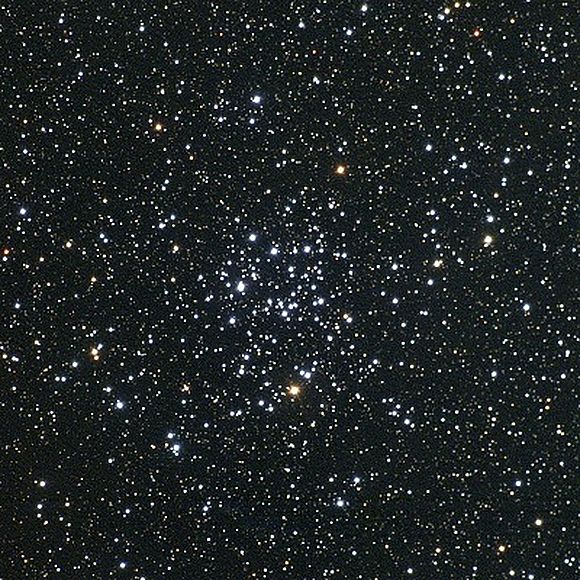
Messier 50 – Image courtesy of NOAO. NSF.
The Rosette Nebula (NGC 2237, NGC 2238, NGC 2239, NGC 2244, NGC 2246) is a large emission nebula in Monoceros. It is an H II region positioned near a large molecular cloud. The open cluster NGC 2244, discovered by the English astronomer John Flamsteed in 1690, is associated with the nebula, the stars having been formed from the matter within the nebula. The cluster contains several exceptionally hot, O-type stars that emit large amounts of radiation and generate stellar wind. The The two brightest members in the cluster are 'O' type stars with masses in excess of 50 times our Sun, being over 400,000 times more luminous than the Sun. The cluster has a visual magnitude of +4.8. The Nebula has a visual magnitude of 9.0 and is about 5,200 light years distant. It is about 65 light years in radius. It has several NGC designations: NGC 2237, NGC 2238, NGC 2239, NGC 2244, and NGC 2246. All except NGC 2244 designate parts of the nebulous region, and NGC 2237 is also used to denote the entire nebula.
The Christmas Tree Cluster and Cone Nebula (NGC 2264-New General Catalogue designation for two deep sky objects). There are two other objects that fall within this designation, but are not officially included: the Snowflake Cluster and the Fox Fur Nebula.
The Christmas Tree Cluster is an open cluster with an overall visual magnitude of 3.9. It is about 2,400 light years distant. The Cone Nebula is an H II region in the southern part of NGC 2264, about 2,700 light years from Earth. It was discovered by William Herschel in December 1785 and is part of the nebulous region around the Christmas Tree cluster. The nebula is 7 light years long. Over millions of years radiation from hot, young stars has slowly eroded the nebula whilst Ultraviolet light heats the edges of the dark cloud, releasing gas into the relatively empty region of surrounding space. There, additional ultraviolet radiation causes the hydrogen gas to glow, which produces the red halo of light seen around the cone pillar.
In the image above the Cone Nebula is located to the left hand side with the inverted Christmas Tree Cluster to the right. The bright variable star, V429 Monocerotis shining just above the cone marks the top of the tree. The brighter star at the centre of the tree trunk is S Monocerotis. The Fox Fur Nebula is at the top right corner. The Snowflake cluster/nebula is in the middle which shows up better on the infrared image. The Snowflake Cluster is a cluster that resembles the pattern of a snowflake. It is about 2,400 light years distant from Earth. The Fox Fur Nebula is a diffuse dark nebula in NGC 2264, approximately 2,700 light years distant.
Hubble’s Variable Nebula (NGC 2261) is a variable nebula illuminated by the light of the star R Monocerotis. The nebula was imaged by Edwin Hubble in 1949. One of the explanations for the nebula’s variability is that its dense dust clouds periodically block the light of the central star, which is completely enveloped by the nebula and not visible itself. Hubble’s Variable Nebula has an apparent magnitude of 9.0 and is approximately 2,500 light years distant from Earth.
NGC 2254 is an open cluster in Monoceros. It contains fewer than 50 stars, but appears to be fairly rich, It has a visual magnitude of 9.7 and is approximately 7,100 light years distant.
The Red Rectangle Nebula (HD 44179) is a protoplanetary nebula in Monoceros. It was discovered in 1973. The binary star system at the centre of the nebula was first observed in 1915. The nebula has an apparent magnitude of 9.02 and is approximately 2,300 light years distant. The compact bipolar nebula envelops the binary star completely, obscuring its light. When the cool star at the centre evolves into a hot white dwarf in the next few thousand years, HD 44179 will become a planetary nebula. The star HD 44179 is surrounded by an extraordinary structure known as the Red Rectangle. It acquired its moniker because of its shape and its apparent colour when seen in early ground based images. Seen by HST, the nebula, rather than being rectangular, is shaped like an X with additional complex structures of spaced lines of glowing gas, a little like the rungs of a ladder.
The Butterfly Nebula (NGC 2346) is a planetary nebula with an apparent magnitude of 11.6. It is approximately 2,000 light years distant. The central star is a spectroscopic binary with a period of about 16 days. It is a variable star, probably as a result of having dust in orbit around it.
There are various other nebulae in Monocerus; NGC 2170 is a reflection nebula discovered by William Herschel in 1784. NGC 2232 is an open cluster located 2.4 degrees to the north and a bit west of the telescopic triple star Beta (β) Monocerotis. It is a large, relatively bright cluster with an overall diameter of 36 arcminutes containing about 20 stars. The cluster has an apparent magnitude of 3.9 and lies approximately 1,305 light years from Earth. The group is best viewed at low power. NGC 2506 is yet another open cluster discovered by William Herschel in 1791. The cluster has an apparent magnitude of 7.6 and is approximately 11,300 light years distant from the Sun.
The Seagull Nebula IC 2177 is an emission nebula about 3,650 light years distant from Earth. The nebula is located on the border between Monoceros and Canis Major. It is an H2 region centred on the star HD 53367. IC 2177 was discovered by the Welsh amateur astronomer Isaac Roberts. This image below shows the intricate structure of part of the Seagull Nebula, known more formally as IC 2177. These wisps of gas and dust are known as Sharpless 2-296 and form part of the “wings” of the celestial bird.
The Seagull Nebula IC 2177 - (Click for larger image)
A fascinating mix of dark and glowing red clouds, weaving amongst bright stars. Image ESO
Monocerus is thus a constellation devoid of bright stars, but overlays a region of the sky rich in colourful star clusters and Nebulae, hidden just beneath the coat of the Unicorn. Not a white coat, but one of many hues, a tartan Unicorn!
- Log in to post comments

